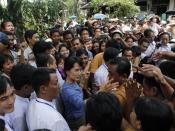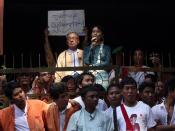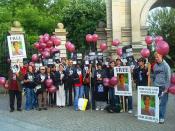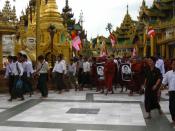Violence in Burma has existed since approximately April 1948. This conflict has been between the Burmese government and various ethnic groups in Burma. Although recently, there has been conflict against the military regime which has been ruling Burma since 1962. This conflict is the oldest ongoing war in the world, and it has therefore received international attention. This is because of the 8888 Uprising in 1988, the work of activist Aung San Suu Kyi and anti-government protests that occurred in late 2007.
Burma is involved in a non-international armed conflict involving a variety of rebellious groups, including militia forces operating predominantly along ethnic lines. The Burma army, known as tatmadaw, has been waging counter-insurgency campaigns against the Karen National Union (KNU), who support human rights and democracy, and its armed wing (the Karen National Liberation Army, KNLA) for nearly 60 years, as well as against the Shan State Army and Karenni ethnic rebel groups.
These groups are situated near the border with Thailand and Naga rebels based within north-western Burma near the Indian border.
The 8888 Uprising was a series of demonstrations, marches, riots and protests on 8th August 1088, hence the 8888. It was the result of the fact that Burmese socialism turned Burma into on of the worldÃÂs most impoverished countries. Nearly everything was nationalised and the government combined ÃÂSoviet-styleÃÂ of central planning and superstition. It was started by students in Yangon and it led to student protests over the country. It then involved monks, university students, housewives, young children and doctors who were protesting against the new regime. It ended on 18th September 1988 after a violent military coup. Thousands were killed but Burmese authorities censored the number to 350. Aung San Suu Kyi became a national icon from these protests. Her party (National League for Democracy) won the military junta organised 1990 election. The military refused to recognise the win and placed Aung San Suu Kyi under house arrest.
In November 2005, the military junta started moving the government away from Yangon to a place near Kyatpyay, which is just outside Pyinmana, to a newly selected capital city. This public event was a follow up of a long term informal policy of relocating critical military and government infrastructure from Yangon to avoid a repetition of the 1988 uprising. On Armed Forces Day (March 27, 2006), the capital was officially named Naypyidaw Myodaw (Royal City of the Seat of Kings); it is commonly referred to as Naypyidaw. Over 7,000 people, most of who were participating in the anti-government uprisings, have been killed in this conflict.
Since 2006, an offensive of the Burmese army against the Karen National Union has been taking place in Karen State. This is resulting in the displacement of tens of thousands of civilians. It is estimated that half a million people have been displaced within eastern Burma as a result of the armed conflict and the aggressive relocation of villages.
The 2007 Burmese anti-government protests were a series of anti-government protests that Buddhist monks started in Rangoon on September 18, 2007. This was an initially peaceful response to the military increasing the price of diesel and petrol by 66% and the price of compressed natural gas for buses by five all in less than a week. Police beat up to 700 protesters. 200 monks were arrested and 100 monks were taken by security forces when a monastery at Ngwe Kyaryan was raided. Tear gas was reportedly used to disperse monks.
In recent reports, the Burmese government has accused the governments of the United Kingdom, France and Singapore for giving incentives to rebels who are against Burma. France had also planned for talks with Thailand to join the incentives.
Today organisations out of the ethnic groups of the Karen and Shan (Myanmar National Democratic Alliance Army) in the east of the country fight against the government. Due to the conflicts, around 160,000 Burmese refugees live in Thailand and many more live in other countries in the region. Thailand has formed humanitarian organisations to help these refugees.
Some argue that a civil war would have started in 1948 as the result of the social, economic and political background of the country and consequently current violence could not be considered an isolated phenomenon. The resulting conflict that began in Burma has been considered questionable by some. Although, many indicate that the conflict's characteristics, scale and intensity have not reached those of a full blown civil war.
BibliographyÃÂVarious, June 1971-May 1972, A Current Affairs Bulletin, Vol. 48, Department of Adult Education in the University of Sydney, Sydney.
ÃÂVarious, November 1959-May 1960, A Current Affairs Bulletin, Vol. 25, Department of Adult Education in the University of Sydney, Sydney.
ÃÂVarious, June 1991-May 1992, A Current Affairs Bulletin, Vol. 68, Department of Adult Education in the University of Sydney, Sydney.
ÃÂVarious, October/November 93, A Current Affairs Bulletin, Vol. 73, No.3, Department of Adult Education in the University of Sydney, Sydney.
ÃÂRule of Law in Armed Conflict Project, 2009, Geneva Academy of International Humanitarian Law and Human Rights, Switzerland, 4 September, 2009, http://www.adh-geneva.ch/RULAC/index.php.
ÃÂCNN.com, 2009, Cable News Network, Worldwide, 4 September, 2009, http://edition.cnn.com/.
ÃÂWikinews, 2009, Wikimedia Foundation, Inc., Worldwide, 4 September, 2009, http://en.wikinews.org/wiki/Main_Page.
ÃÂEncyclopedia.com, 2009, HighBeam Research, Inc., Worldwide, 5 September, 2009, http://www.encyclopedia.com/.
ÃÂDaily News and Economic Review, 2009, Hürriyet Daily News and Economic Review, 5 September, 2009, http://www.hurriyetdailynews.com/index.php.
ÃÂUSAID, September, 2009, U.S. Agency for International Development, United States, 5 September, 2009, http://www.usaid.gov/.





